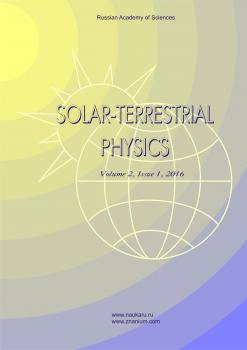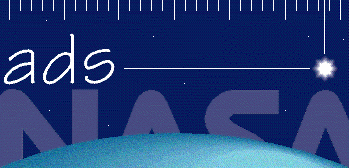Иркутск, Россия
Иркутск, Иркутская область, Россия
Иркутск, Россия
Иркутск, Россия
Multi-wavelength observations of a coronal hole (CH) with two-dimensional spatial resolution have been made for the first time in the frequency range from 2.8 to 12 GHz. At frequencies below 6 GHz, the average brightness of the hole is 1.5 times lower than the brightness level of the quiet Sun. The distribution of radio brightness over the hole is inhomogeneous: the ratio of maximum to minimum brightness temperatures falls from several times at low frequencies to tenths of fractions at the upper received frequencies. At frequencies above 6 GHz, the temperature contrast between the CH and regions of the quiet Sun is small. Within the CH, there are compact sources that are bright relative to the quiet Sun. In general, observations of CHs with SRH are promising both for the research into the nature of CHs and for the applied problems of forecasting solar wind characteristics.
Sun, radio emission, bremsstrahlung, coronal holes
1. Akiyama S., Gopalswamy N., Yashiro S., Mäkelä P. A study of coronal holes observed by SOHO/EIT and the Nobeyama Radioheliograph. Publications of the Astronomical Society of Japan. 2013, vol. 65, S15. DOI:https://doi.org/10.1093/pasj/65.sp1.S15.
2. Altyntsev A.T., Lesovoi S.V., Globa M.V., Gubin A.V., Kochanov A.A., Grechnev V.V., Ivanov E.F., et al. Multiwave Siberian Radioheliograph. Solar-Terr. Phys. 2020, vol. 6, iss. 2, pp. 30–40. DOI:https://doi.org/10.12737/stp-62202003.
3. Bogod V.M., Grebinskij A.S. Large-Scale Structure of the atmosphere of the quiet sun, coronal holes, and plages as deduced by tomography study. Solar Phys. 1997, vol. 176, iss. 1, pp. 67–86. DOI:https://doi.org/10.1023/A:1004929418335.
4. Borovik V.N., Kurbanov M.S., Livshits M.A., Ryabov B.I. Coronal holes against the background of the quiet Sun — observations with the RATAN-600 in the 2–32-cm range. Soviet Astronomy. 1990, vol. 34, no. 5, p. 522.
5. Borovik V.N., Kurbanov M.S., Makarov V.V. Distribution of radio brightness of the quiet Sun in the 2–32-cm range. Soviet Astronomy. 1992, vol. 36, no. 6/NOV, p. 656.
6. Borovik V.N., Medar V.G., Korzhavin A.N. First measurements of the magnetic field in a coronal hole from RATAN-600 radio observations of the Sun. Astron. Lett. 1999, vol. 25, iss. 4, pp. 250–257.
7. Cranmer S.R. Coronal Holes. Living Reviews in Solar Physics. 2009, vol. 6, iss. 1, 3, 66 p. DOI:https://doi.org/10.12942/lrsp-2009-3.
8. Dravskikh A.F., Dravskikh Yu.A. Adiabatic radio emission spectrum of the Sun’s coronal holes. Astron. Rep. 2023, vol. 67, pp. 513–519. DOI:https://doi.org/10.1134/S1063772923050037.
9. Garton T.M., Gallagher P.T., Murray S.A. Expansion of high-speed solar wind streams from coronal holes through the inner heliosphere. Journal of Space Weather and Space Climate. 2018, vol. 8, id. A02, 12 p. DOI:https://doi.org/10.1051/swsc/2017039.
10. Gelfreikh G.B. Coronal magnetic field measurements through bremsstrahlung emission. Solar and Space Weather Radiophysics. 2004, p. 115. DOI:https://doi.org/10.1007/1-4020-2814-8_6.
11. Globa M.A., Lesovoi S.V. Calibration of Siberian Radioheliograph antenna gains using redundancy. Solar-Terr. Phys. 2021, vol. 7, iss. 4, pp. 98–103. DOI:https://doi.org/10.12737/stp-74202111.
12. Golubchina O.A. Investigation of the polar coronal hole in the Sun with RATAN-600 in the centimeter radio range. POS. Vol. 425: The Multifaceted Universe: Theory and Observations – 2022 (MUTO2022). 2022, 063. URL: https://pos.sissa.it/425/063/pdf (accessed 19.06.2024).
13. Gopalswamy N., Shibasaki K., Thompson B.J., Gurman J., DeForest C. Microwave enhancement and variability in the elephant's trunk coronal hole: Comparison with SOHO observations. J. Geophys. Res. 1999, vol. 104, pp. 9767–9780. DOI:https://doi.org/10.1029/1998JA900168.
14. Grechnev V.V., Lesovoi S.V., Smolkov G.Ya., Krissinel B.B., Zandanov V.G., Altyntsev A.T., et al. The Siberian Solar Radio Telescope: the current state of the instrument, observations, and data. Solar Phys. 2003, vol. 216, pp. 239–272. DOI:https://doi.org/10.1023/A:1026153410061.
15. Illarionov E.A., Tlatov A.G. Segmentation of coronal holes in solar disc images with a convolutional neural network. Monthly Notices of the Royal Astronomical Society. 2018, vol. 481, iss. 4, pp. 5014–5021. DOI:https://doi.org/10.1093/mnras/sty2628.
16. Kosugi T., Ishiguro M., Shibasaki K. Polar-cap and coronal-hole-associated brightenings of the Sun at millimeter wavelengths. Publications of the Astronomical Society of Japan. 1986, vol. 38, pp. 1–11.
17. Krieger A.S., Timothy A.F., Roelof E.C. A coronal hole and its identification as the source of a high velocity solar wind stream. Solar Phys. 1973, vol. 29, pp. 505–525. DOI: 10.1007/ BF00150828.
18. Krissinel B.B., Kuznetsova S.M., Maksimov V.P., Prosovetsky D.V., Grechnev V.V., Stepanov A.P., Shishko L.F. Some features of manifestations of coronal holes in microwave emission. 2000. Publications of the Astronomical Society of Japan. 2000, vol. 52, iss. 5, pp. 909–917. DOI:https://doi.org/10.1093/pasj/ 52.5.909.
19. Lesovoi S.V., Altyntsev A.T., Ivanov E.F., Gubin A.V. The Multifrequency Siberian Radioheliograph. Solar Phys. 2012, vol. 280, pp. 651–661. DOI:https://doi.org/10.1007/s11207-012-0008-7.
20. Maksimov V.P., Prosovetsky D.V. Coronal heating in the coronal holes regions. Solar Variability: From Core to outer Frontiers. The 10th European Solar Physics Meeting, 9–14 September 2002, Prague, Czech Republic. ESA SP-506, Vol. 2. Noordwijk: ESA Publications Division, 2002, pp. 689–692.
21. Maksimov V.P., Prosovetsky D.V., Grechnev V.V., Krissinel B.B., Shibasaki K. On the relation of brightness temperatures in coronal holes at 5.7 and 17 GHz. Publications of the Astronomical Society of Japan. 2006, vol. 58, pp. 1–10. DOI:https://doi.org/10.1093/pasj/58.1.1.
22. Moran T., Gopalswamy N, Dammasch I.E., Wilhelm K. A multi-wavelength study of solar coronal-hole regions showing radio enhancements. Astron. and Astrophys. 2001, vol. 378, pp. 1037–1045. DOI:https://doi.org/10.1051/0004-6361:20010569.
23. Nakajima H., Nishio M., Enome S., Shibasaki K., Takano T., Hanaoka Y., Torii C., et al. The Nobeyama Radioheliograph. Proc. IEEE. 1994, vol. 82, pp. 705–713.
24. Nolte J.T., Krieger A.S., Timothy A.F., Gold R.E., Roelof E.C., Vaiana G., Lazarus A.J., Sullivan J.D., McIntosh P.S. Coronal holes as sources of solar wind. Solar Phys. 1976, vol. 46, pp. 303–322. DOI:https://doi.org/10.1007/BF00149859.
25. Obridko V.N., Shelting B.D., Livshits I.M., Asgarov A.B. Contrast of Coronal Holes and Parameters of Associated Solar Wind Streams. Solar Phys. 2009, vol. 260, pp. 191–206. DOI:https://doi.org/10.1007/s11207-009-9435-5.
26. Papagiannis M.D., Baker K.B. Determination and Analysis of Coronal Hole Radio Spectra. Solar Phys. 1982, vol. 79, pp. 365–374. DOI:https://doi.org/10.1007/BF00146252.
27. Pohjolainen S., Portier-Fozzani F., Ragaigne D. Comparison of 87 GHz solar polar structures with EUV and soft X-ray emission. American Astronomical Society. 2000, vol. 143, pp. 227–263. DOI:https://doi.org/10.1051/aas:2000179.
28. Reiss M.A., Temmer M., Veronig A.M., Nikolic L., Vennerstrom S., Schöngassner F., Hofmeister S.J. Verification of high-speed solar wind stream forecasts using operational solar wind models. Space Weather. 2016, vol. 14, pp. 495–511. DOI:https://doi.org/10.1002/2016SW001390.
29. Rotter Т., Veronig A.M., Temmer M., Vršnak B. Relation Between coronal hole areas on the sun and the solar wind parameters at 1 AU. Solar Phys. 2012, vol. 281, pp. 793–813. DOI:https://doi.org/10.1007/s11207-012-0101-y.
30. Rotter Т., Veronig A.M., Temmer M., Vršnak B. Real-time solar wind prediction based on SDO/AIA coronal hole data. Solar Phys. 2015, vol. 290, pp. 1355–1370. DOI:https://doi.org/10.1007/s11207-015-0680-5.
31. Verbeeck C., Delouille V., Mampaey B., De Visscher R. The SPoCA-suite: Software for extraction, characterization, and tracking of active regions and coronal holes on EUV images. Astron. Astrophys. 2014, vol.561, id. A29, 16 p. DOI: 10.1051/ 0004-6361/201321243.
32. Vršnak B., Temmer M., Veronig A.M. Coronal holes and solar wind high-speed streams: I. Forecasting the solar wind parameters. Solar Phys. 2007, vol. 240, pp. 315–330. DOI:https://doi.org/10.1007/s11207-007-0285-8.
33. Zirin H., Baumert B.M., Hurford G.J. The microwave brightness temperature spectrum of the quiet Sun. Astrophys. J. 1991, vol. 370, p. 779. DOI:https://doi.org/10.1086/169861.
34. Wang Y.-M., Sheeley N.R., Jr. Solar wind speed and coronal flux-tube expansion. Astrophys. J. 1990, vol. 355, p. 726. DOI:https://doi.org/10.1086/168805.
35. URL: https://badary.iszf.irk.ru/srhDaily.php (accessed May 19, 2024).
36. URL: https://SolarMonitor.org (accessed May 19, 2024).
37. URL: https://suntoday.lmsal.com (accessed May 19, 2024).
38. URL: http://ckp-rf.ru/ckp/3056/ (accessed May 19, 2024).
39. URL: https://ckp-rf.ru/catalog/usu/4138190/ (accessed May 19, 2024).


















